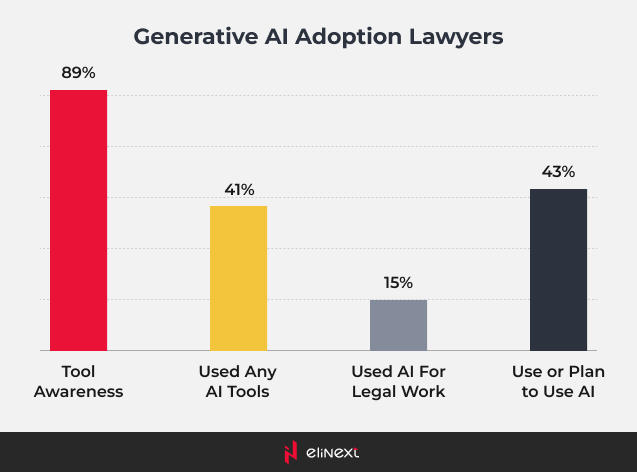Artificial Intelligence (AI) technology alters the way legal firms process documents, and conduct their research.
As ChatGPT made everyone treat AI seriously, law firms started to look for opportunities to incorporate those advanced systems and similar legal document review AI software into their workflow. Generative AI allows legal professionals to improve the document review process, saving money and effort for law firms and their clients.
According to the survey American Bar Association held last year, 35% of law firms use AI-driven software in their everyday practice, including 55% of companies sized 500+. According to the stats, legal document review AI software adoption among big law firms is higher, with just 20% of firms with under 100 employees trying to incorporate AI for legal research.
In this article, we’ll explore one of the most common applications of AI by law firms, the AI document review. We’ll figure out the way it works, and assess its impact.
What Is AI Document Review and How It Works
Legal firms handle tons of documents. It is a no-brainer, that automatization of the process could significantly impact their workflow.
AI-powered document review allows analysis of large volumes of e-documents and their categorisation based on their relevance to a certain legal case. As AI for legal research prove to become more efficient, many firms start using it in their operation for a bigger number of tasks.
At the very least, AI solutions are being used for producing document summaries, conducting complicated searches through different file systems, surface documents, etc.
Elinext develops systems that enable document review and support lawyers with writing assistance. That way, attorneys get immediate access to the critical information on their cases. If you’re looking for a way to improve the operations of your legal teams, contact us, and let’s discuss.
Normally, legal document review AI software document review uses machine learning (ML) algorithms to find patterns between documents. Machine Learning solutions groups similar documents and find the needed details within the files. Document analysis offers insights and helps to gain an advantage by speeding up the process and delivering summaries. That eliminates the need for lawyers to read documents through.
Two Types of AI Document Review
There are two primary ways AI can help layers with documents: the so-called Technology-Assisted Review (TAR), and world-renowned Generative AI. TAR is used more frequently at the moment, but generative AI also has its cases and has great potential.
TAR
Technology-assisted review is the best you could get for your case, and its usage is allowed and even endorsed by many courts during the e-discovery process among other stages. Essentially, attorneys get a quicker way to review document files. However, there are things TAR wouldn’t be very helpful with.
For instance, TAR is great for text-heavy documents, but there are so many more types of data storage it won’t help you out with text messages or videos that are oftentimes a part of discovery evidence.
Generative AI
Generative AI is not being used widely at the moment, but is undeniably an emerging technology, and will be used more often in the future. Deloitte’s poll states that 66% of their respondents believe that GenAI can automate routine tasks to improve employee work experiences.
By using ML algorithms, it helps to summarise the content or surface the most relevant information at the very least. GenAI is not limited to just text analysis it can review whatever: from video to Skype messages, and its use goes further, beyond simple document review.
According to LexisNexis international legal Generative AI Report, 89% of lawyers are aware of GenAI technologies, and 41% of them used AI tools. However, only 15% of respondents used AI for legal research and otherwork.

Generative AI Adoption Among Lawyers
Source: docuease.com
Perhaps, the most promising statistic is that 43% of layers have the intention to use AI for their professional activities.
How Lawyers Can Utilize AI Document Review
Depending on how your legal team looks like, how many lawyers it includes, and the routine they use during their daily practice, they might benefit from AI use in several ways. Let’s discuss the most common use cases.
Ediscovery
AI offers an big range of tools that help layers during the eDiscovery process, precisely, during its review phase. Integrating AI in legal research with traditional eDiscovery tools reshapes document review by reducing time and cost while boosting accuracy.
PwC notices that Ai is especially helpful with multilingual document review (no spending of time and money on hiring human translators). AI continuously learns and improves through exposure to data, so even a small set of hand-reviewed documents can rapidly expand its knowledge base. By learning your preferences and requirements, AI tailors its output, ultimately saving both time and resources.
Natural Language Processing (NLP) enables AI to perform complex tasks such as identifying entities, analyzing sentiment, and translating languages, all of which contribute to a more refined and accurate understanding of documents. Additionally, AI-powered Optical Character Recognition (OCR) converts scanned documents and images into searchable, editable text, streamlining searches and enabling faster, more comprehensive retrieval of information.
These are just some of the ways AI is transforming the legal field today. In the next section, we’ll explore the future possibilities of AI in advancing legal research.
Future of AI in Legal Research
AI-driven document review platforms can now process enormous volumes of text, isolate essential details, and flag potential issues with a speed and accuracy unmatched by manual review. This capability is revolutionizing eDiscovery by enabling AI to rapidly sift through multilingual documents, providing instant translation and categorizing documents by relevance with the help of various data analytics services.
Predictive coding and continuous learning models allow AI to analyze a small sample of documents and apply the learned insights to the larger set, intelligently prioritizing documents that require human review.
Contract review is also becoming significantly more efficient with AI. These tools can highlight high-risk clauses, propose modifications based on organizational standards, and verify regulatory compliance, allowing legal professionals to focus on strategic oversight rather than manual editing and clause-by-clause scrutiny.
Beyond document review, AI’s potential includes automated organization, tagging, and categorization of documents, which drastically improves searchability and retrieval times. When integrated with legal workflows, such as e-signature and approval systems, AI creates a seamless, more efficient legal process.
With these advancements, AI is poised to become an indispensable tool in the legal industry, enhancing productivity, precision, and confidence across document-intensive tasks.
In-Depth Analysis of Key Challenges
There are challenges AI has to overcome to have a more widespread presence in legal practice. Let’s list the major ones among them.
Unjust Outcomes and Bias
One major concern with AI in legal research is the risk of biased or unjust decisions. Unlike humans, AI lacks contextual judgment and relies strictly on data patterns, which can sometimes reinforce historical biases. For instance, predictive tools in criminal justice have shown a tendency to disproportionately impact minority groups, reflecting pre-existing biases within the training data.
Lack of Transparency
Advanced AI systems, particularly those using machine learning, often operate as “black boxes,” making it difficult to understand their decision-making processes. This lack of transparency is concerning in the legal field, where accountability and clarity are crucial. AI in legal research helps a lot, but without insight into how AI reaches certain conclusions, it can be challenging for clients and legal professionals to fully trust AI-driven outcomes.
Privacy Risks
Legal AI tools typically need access to sensitive client data, raising concerns about data privacy. AI-driven data analysis could potentially misuse or inadvertently expose private information, risking compliance with strict data protection laws. The legal field must carefully weigh the advantages of AI insights against the need to protect client confidentiality.
Conclusion
In conclusion, AI in legal research and document review causes a huge trasformation, offering powerful tools for efficiency, accuracy, and cost reduction. At Elinext, we recognize the potential of AI to drive innovation and improve legal workflows, from eDiscovery to contract management and beyond. While AI’s integration brings challenges such as transparency, privacy, and bias, careful implementation and ethical considerations can mitigate these risks and harness AI’s benefits responsibly.
As AI in legal research continues to evolve, law firms can look forward to more streamlined processes and valuable insights that free legal professionals to focus on strategy and client service.
Elinext is committed to delivering custom software development services to legal companies/ AI empowers legal teams to work smarter, navigate complex information, and ultimately deliver better outcomes. Reach out to discuss how Elinext can support your organization’s journey into AI-powered legal technology.









